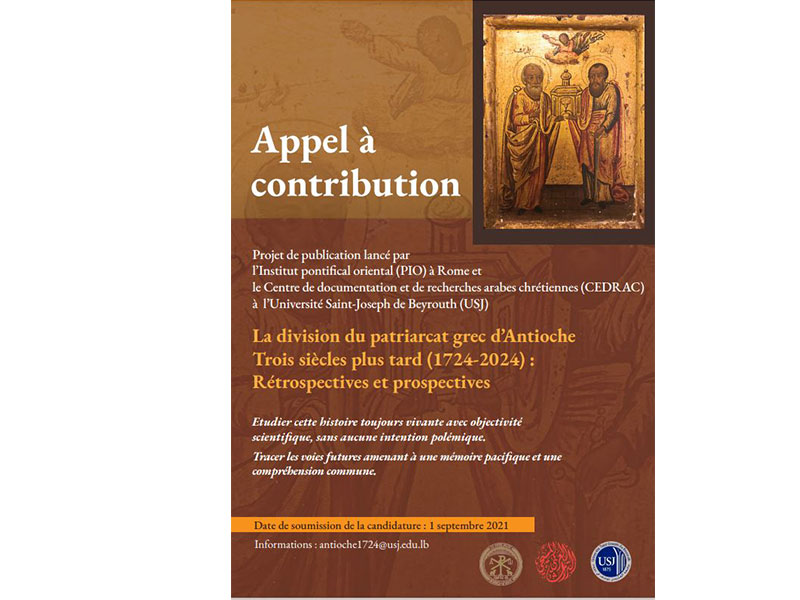| Download the poster | French version |
The Split in the Greek Patriarchate of Antioch
Three Centuries Later (1724-2024)
Retrospective and Prospect
Theme
In July 1724, the See of the Greek (known also as Rūm) patriarch of Antioch was claimed by two titulars, Cyril Ṭānās (previously known as Seraphim) and Sylvester of Cyprus. Unlike the rivalries between candidates that were common in the See of Antioch, this double election, in a very particular ecclesial, economic and political context, resulted in the creation of two separate Churches.
In the wake of the Reformation in the West and the resulting context of competition between churches, the Church of Rome in turn undertook a cultural project of reform of its institutions that also touched the lives of the faithful. During a period of less than a century, from around 1650 to 1750, the Latin missionaries succeeded, with the support, and sometimes with the interference of European embassies, in creating a movement for union. At the same time, the Greek patriarchs of Constantinople and Jerusalem intensified their efforts to bring Antioch into “Orthodoxy”. After a period of Latin influence, several local church leaders sought to distance themselves more and more from Catholicism and the Western Reformation.
The local prelates were materially and culturally impoverished, albeit endowed with a network of support by the Orthodox powers (Romanian principalities and Russia) and even from the Porte, but they tolerated the pastoral and spiritual contribution of the Latin missionaries and benefited from the commercial support offered by the label “Catholic”, insofar as it was still possible to manage the mounting pressures.
Following the double patriarchal election of 1724, the Greek Antiochian community gradually drifted into two distinct Churches, one Orthodox and the other Catholic. The markers of differentiation between these two communities multiplied in a framework of a more general competition. Over time, the (re-)construction of the narrative surrounding the division of 1724 was, to varying degrees, subjugated to polemical agendas meant to develop an identity of opposition to the other.
Roman missionary activity and the Orthodox reaction were, among other factors, the catalyst for a literary production mainly in Arabic, whose major character was apologetic and polemic. It could be considered that this climate of intellectual and literarily emulation, among other factors, paved the way for the Nahḍah movement.
In this confrontation, a clash of different ecclesiological visions took place. The arsenal of Latin arguments accumulated in the wake of the Counter-Reformation entered Catholic circles mainly through the Maronites. On the other hand, Byzantine arguments against papal primacy and infallibility were taken up by the Antiochian Orthodox not without a tinge of pride in being a Church of Petrine foundation.
The CEDRAC and the PIO plan to publish a systematic and ecumenical study planned for 2024 to commemorate the third centenary of the split of the Greek Patriarchate of Antioch. The objective is to revisit what was at stake in this "cold-blooded" division. The approach aims to revisit the history of the split with scientific objectivity, without any polemical intention and in the hope of charting future paths towards a peaceful memory and common understanding.
The publication will thus be organized according to the following five areas:
1- Historical Context: Focusing on the split itself, the event and its context (17th to the 18th century);
2- Historiography: Dealing with the post-division narratives;
3- Polemical Literature: Dealing with the controversial texts of that time;
4- Ecclesiology: Elucidating the historical development of the underlying theologies and ecclesiastical practices;
5- Ecumenical Perspective: Addressing the past and contemporary significance of the split and opens up future perspectives and new horizons.
This study will be published by CEDRAC in the series “Textes et études sur l’Orient chrétien” (TÉSOC).
The contribution
A contribution must not exceed 6,000 words, including a bibliography (following international academic standards) and an easily readable abstract. It is to be written in a clear and engaging style accessible to a wide audience.
How to participate?
If you are interested in this call, please send an application to antioche1724@usj.edu.lb consisting of:
1. A curriculum vitae;
2. A working title and an abstract of 500 words
Calendar
|
June 1, 2021: |
Submission of the application |
|
September 30, 2021 |
Answer of the committee |
|
September 30, 2022: |
Submission of the paper |
|
|
Peer Review. Corrections of the papers. Proofing. |
|
January 2024: |
Publishing |
|
May 2024: |
Academic event |
Coordinators:
Ronney el Gemayel, SJ, (CEDRAC-USJ)
Željko Paša, SJ (PIO)
Editors:
Bernard Heyberger (EHESS/EPHE)
Gabriel Hachem (USJ)
Assaad Kattan (University of Münster)
Scientific Board:
- Erickson John (St. Vladimir’s Orthodox Theological Seminary)
- Farrugia Edward (Pontifical Oriental Institute)
- Feodorov, Iona (Institute for South East European Studies |Romanian Academy) (=ISSEE, Romanian Academy) [PR1]
- Gabriel Frédéric (CNRS)
- Hainthaler Theresia (Sankt Georgen, Frankfurt)
- Kolbaba Tia (Rutgers University)
- Kontouma Vassa (EPHE),
- Luisier Philippe (Pontifical Oriental Institute)
- Masri Pierre (Pontificio Istituto di Studi Arabi e d'Islamistica)
- Masters Bruce (Wesleyan University)
- Murre-van den Berg, Heleen (Radboud University)
- Noble Samuel (KU Leuven)
- Sicking Thom (Université Saint-Joseph)
- Slim Souad (University of Balamand)
- Teule Herman (KU Leuven)
Contact and information: antioche1724@usj.edu.lb
